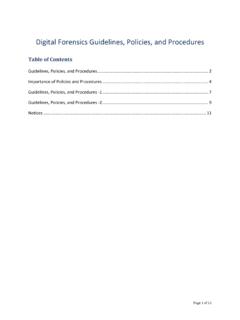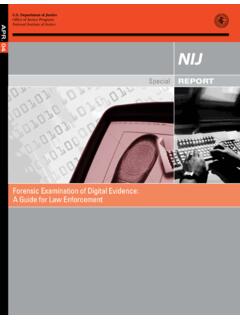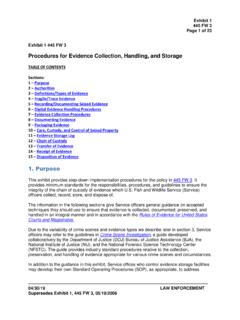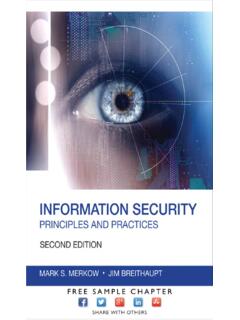Transcription of Guidelines on Mobile Device Forensics - NIST
1 NIST Special Publication 800-101 Revision 1 Guidelines on Mobile Device Forensics Rick Ayers Sam Brothers Wayne Jansen NIST Special Publication 800-101 Revision 1 Guidelines on Mobile Device Forensics Rick Ayers Software and Systems Division Information Technology Laboratory Sam Brothers Customs and Border Protection Department of Homeland Security Springfield, VA Wayne Jansen Booz Allen Hamilton McLean, VA 800-101r1 May 2014 Department of Commerce Penny Pritzker, Secretary National Institute of Standards and Technology Patrick D. Gallagher, Under Secretary of Commerce for Standards and Technology and Director II Authority This publication has been developed by NIST in accordance with its statutory responsibilities under the Federal Information Security Management Act of 2002 (FISMA), 44 3541 et seq.
2 , Public Law ( ) 107-347. NIST is responsible for developing information security standards and Guidelines , including minimum requirements for Federal information systems, but such standards and Guidelines shall not apply to national security systems without the express approval of appropriate Federal officials exercising policy authority over such systems. This guideline is consistent with the requirements of the Office of Management and Budget (OMB) Circular A-130, Section 8b(3), Securing Agency Information Systems, as analyzed in Circular A-130, Appendix IV: Analysis of Key Sections. Supplemental information is provided in Circular A-130, Appendix III, Security of Federal Automated Information Resources. Nothing in this publication should be taken to contradict the standards and Guidelines made mandatory and binding on Federal agencies by the Secretary of Commerce under statutory authority.
3 Nor should these Guidelines be interpreted as altering or superseding the existing authorities of the Secretary of Commerce, Director of the OMB, or any other Federal official. This publication may be used by nongovernmental organizations on a voluntary basis and is not subject to copyright in the United States. Attribution would, however, be appreciated by NIST. National Institute of Standards and Technology Special Publication 800-101r1 Natl. Inst. Stand. Technol. Spec. Publ. 800-101 Revision 1, 87 pages (May 2014) 800-101r1 CODEN: NSPUE2 Certain commercial entities, equipment, or materials may be identified in this document in order to describe an experimental procedure or concept adequately. Such identification is not intended to imply recommendation or endorsement by NIST, nor is it intended to imply that the entities, materials, or equipment are necessarily the best available for the purpose.
4 There may be references in this publication to other publications currently under development by NIST in accordance with its assigned statutory responsibilities. The information in this publication, including concepts and methodologies, may be used by Federal agencies even before the completion of such companion publications. Thus, until each publication is completed, current requirements, Guidelines , and procedures , where they exist, remain operative. For planning and transition purposes, Federal agencies may wish to closely follow the development of these new publications by NIST. Organizations are encouraged to review all draft publications during public comment periods and provide feedback to NIST. All NIST Computer Security Division publications, other than the ones noted above, are available at III Reports on Computer Systems Technology The Information Technology Laboratory (ITL) at the National Institute of Standards and Technology (NIST) promotes the economy and public welfare by providing technical leadership for the Nation s measurement and standards infrastructure.
5 ITL develops tests, test methods, reference data, proof of concept implementations, and technical analyses to advance the development and productive use of information technology. ITL s responsibilities include the development of management, administrative, technical, and physical standards and Guidelines for the cost-effective security and privacy of other than national security-related information in Federal information systems. The Special Publication 800-series reports on ITL s research, Guidelines , and outreach efforts in information system security, and its collaborative activities with industry, government, and academic organizations. Abstract Mobile Device Forensics is the science of recovering digital evidence from a Mobile Device under forensically sound conditions using accepted methods.
6 Mobile Device Forensics is an evolving specialty in the field of digital Forensics . This guide attempts to bridge the gap by providing an in-depth look into Mobile devices and explaining technologies involved and their relationship to forensic procedures . This document covers Mobile devices with features beyond simple voice communication and text messaging capabilities. This guide also discusses procedures for the validation, preservation, acquisition, examination, analysis, and reporting of digital information. Keywords cell phone Forensics ; forensic tools; Mobile devices ; Mobile Device Forensics ; Mobile Device tools; smart phones IV Acknowledgements The authors, Rick Ayers from NIST, Sam Brothers from Customs and Border Protection and Wayne Jansen from Booz-Allen-Hamilton, wish to thank colleagues who reviewed drafts of this document.
7 In particular, our appreciation goes to Barbara Guttman from NIST and Simson Garfinkle from the Naval Postgraduate School for their technical support and written contributions to this document. Our appreciation also goes out to Bob Elder from TeelTech Canada, Gary Kessler from Gary Kessler Associates, Rick Mislan from Rochester Institute of Technology and Daren Melson for their assistance on technical issues that arose in our work. The authors would also like to thank all others who assisted with our review process. Guidelines on Mobile Device Forensics V Table of Contents TABLE OF CONTENTS .. V LIST OF FIGURES .. VII LIST OF TABLES .. VIII EXECUTIVE 1 1. INTRODUCTION .. 1 PURPOSE AND SCOPE .. 1 AUDIENCE AND ASSUMPTIONS .. 1 DOCUMENT STRUCTURE .. 1 2. BACKGROUND.
8 3 Mobile Device CHARACTERISTICS .. 3 MEMORY CONSIDERATIONS .. 5 IDENTITY MODULE CHARACTERISTICS .. 7 CELLULAR NETWORK CHARACTERISTICS .. 10 OTHER COMMUNICATIONS SYSTEMS .. 12 3. forensic TOOLS .. 15 Mobile Device TOOL CLASSIFICATION SYSTEM .. 15 UICC TOOLS .. 23 OBSTRUCTED devices .. 24 forensic TOOL CAPABILITIES .. 25 4. PRESERVATION .. 27 SECURING AND EVALUATING THE SCENE .. 27 DOCUMENTING THE SCENE .. 28 ISOLATION .. 28 PACKAGING, TRANSPORTING, AND STORING EVIDENCE .. 33 ON-SITE TRIAGE PROCESSING .. 33 GENERIC ON-SITE DECISION 35 5. ACQUISITION .. 37 Mobile Device IDENTIFICATION .. 37 TOOL SELECTION AND EXPECTATIONS .. 39 Mobile Device MEMORY ACQUISITION .. 40 TANGENTIAL EQUIPMENT .. 45 CLOUD BASED SERVICES FOR Mobile devices .. 46 6.
9 EXAMINATION AND ANALYSIS .. 48 POTENTIAL EVIDENCE .. 48 APPLYING Mobile Device forensic TOOLS .. 50 CALL AND SUBSCRIBER RECORDS .. 52 Guidelines on Mobile Device Forensics VI 7. REPORTING .. 55 8. REFERENCES .. 58 BIBLIOGRAPHIC CITATIONS .. 58 FOOTNOTED URLS .. 62 APPENDIX A. ACRONYMS .. 64 APPENDIX B. GLOSSARY .. 67 APPENDIX C. STANDARDIZED CALL RECORDS .. 72 APPENDIX D. ONLINE RESOURCES FOR Mobile Device Forensics .. 75 Guidelines on Mobile Device Forensics VII List of Figures Figure 1: Memory Configurations .. 6 Figure 2: SIM Card Size Formats [Orm09] .. 8 Figure 3: SIM File System (GSM) .. 9 Figure 4: Cellular Network Organization .. 12 Figure 5: Satellite Phone Network .. 13 Figure 6: Mobile Device Tool Classification System .. 17 Figure 7: Generic Triage Decision Tree.
10 36 Guidelines on Mobile Device Forensics VIII List of Tables Table 1: Hardware Characterization .. 4 Table 2: Software Characterization .. 5 Table 3: Mobile Device forensic Tools .. 21 Table 4: Memory Cards .. 46 Table 5: Example Record Structure .. 72 Table 6: Technical Resource Sites .. 75 Table 7: Databases for Identification Queries .. 75 Guidelines on Mobile Device Forensics ES-1 Executive Summary The digital forensic community faces a constant challenge to stay abreast of the latest technologies that may be used to expose relevant clues in an investigation. Mobile devices are commonplace in today s society, used by many individuals for both personal and professional purposes. Mobile devices vary in design and are continually undergoing change as existing technologies improve and new technologies are introduced.

















